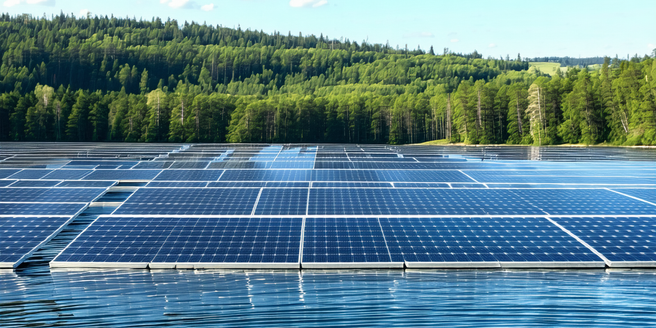
Understanding Floating Solar Technology
Floating solar technology, also known as floatovoltaics, involves the installation of solar panels on water bodies like lakes, reservoirs, and artificial ponds. This innovative approach offers several advantages over traditional solar panels installed on land. Floating solar panels are mounted on buoyant platforms, which help in conserving land and reducing any potential land-use conflicts. Furthermore, the cooling effect of water increases the efficiency of solar panels, as they tend to perform better at lower temperatures. This means that more energy can be generated using the same number of panels. Additionally, floating solar farms can help reduce evaporation in bodies of water, which is particularly beneficial in regions facing water scarcity. This technology is a promising and sustainable option for maximizing renewable energy without compromising ecological balance.
Benefits of Floating Solar in Lake Areas
Floating solar farms offer numerous benefits when implemented in lake areas. One major advantage is the conservation of land, which is particularly important in densely populated or ecologically sensitive regions. By utilizing the surface of lakes, it frees up valuable land resources for other uses such as agriculture or housing. Moreover, the presence of these solar installations can aid in reducing water evaporation, helping to maintain stable water levels. Another significant benefit is that these panels operate more efficiently due to the cooling effect of the water body, which prevents overheating and enhances the panels’ performance. This increased efficiency can translate into higher energy outputs compared to traditional land-based solar panels. Overall, floating solar farms represent a sustainable and effective solution for harnessing renewable energy while simultaneously protecting and preserving lake environments.
Challenges and Solutions in Implementation
While floating solar farms present a promising renewable energy source, their implementation also faces several challenges. One major concern is ensuring the structural integrity of the floating platforms to withstand harsh weather conditions such as storms and strong winds. Advanced engineering solutions, such as the use of durable materials and innovative anchoring techniques, are crucial to address these issues. Another challenge is the potential ecological impact on aquatic life and water quality. It’s important to conduct thorough environmental assessments to identify and mitigate any negative consequences, ensuring minimal disruption to the ecosystem. Additionally, the cost of installation and maintenance can be higher than land-based solar systems, so continuing to innovate and reduce these costs is essential for widespread adoption. By addressing these challenges, floating solar farms can become a viable, scalable option for sustainable energy production.
Environmental Impact and Sustainability
Floating solar farms have garnered attention for their potential positive environmental impacts and sustainability. By covering a small surface area of water bodies, these installations can significantly reduce water evaporation, which is beneficial in drought-prone regions. They can also reduce instances of algal blooms by blocking sunlight, thus maintaining better water quality. Another sustainable aspect of floating solar technology is its reduced use of land resources, allowing for dual land-water use without disturbing natural habitats. However, it’s essential that the design and implementation of such systems consider local biodiversity, ensuring that any potential negative impact on aquatic ecosystems is minimized. With careful planning and execution, floating solar farms represent a harmonious blend of renewable energy generation and environmental stewardship, supporting long-term sustainability goals.
Case Studies: Successful Installations
There are several notable case studies that highlight the success of floating solar farms around the world. For instance, the installation at the Yamakura Dam Reservoir in Japan demonstrates how this technology can efficiently generate power while minimizing land use. This project showcases a large-scale application with over 50,000 panels generating significant renewable energy. In India, the Kerala State Electricity Board has implemented floating solar projects that cater to the region’s specific needs, illustrating versatility in design and scale. Furthermore, in the United States, the town of Sayreville in New Jersey leverages its wastewater treatment ponds to host floating solar panels, demonstrating innovative reuse of water bodies for energy production. These examples underline the adaptability of floating solar technology and its potential to be tailored to meet diverse environmental and energy requirements.
Future Prospects for Lake-Based Solar Farms
The future for lake-based solar farms is promising, as advancements in technology and a growing emphasis on renewable energy create new opportunities. Continued research and development are likely to focus on enhancing the efficiency and durability of solar panels and floating structures, making them suitable for various climatic conditions. Moreover, as the demand for cleaner energy sources rises, there will be an increased emphasis on integrating floating solar systems with other forms of renewable energy, such as wind or hydropower, to create hybrid systems. Government initiatives and incentives can further drive the adoption of this technology by making it economically viable for more regions. As awareness regarding climate change and resource conservation grows, floating solar farms are well-positioned to play a critical role in the transition to sustainable energy patterns on a global scale.
